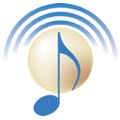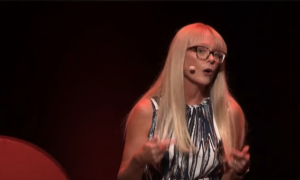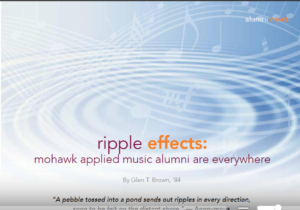The View is a weekly alternative newspaper in Hamilton. One of its useful features is the Weekly Alibi section where you can see what’s going on musically around town, night by night, at the local clubs and pubs.
 I’ve always been blown away by the huge number of bands that are playing around town. For example, during one mid-November week last year, 115 musical acts were listed. A map showing the basic locations of venues is shown here (fig. 1). Think about the amount of local commerce generated by the work of those bands over the course of a few days!
I’ve always been blown away by the huge number of bands that are playing around town. For example, during one mid-November week last year, 115 musical acts were listed. A map showing the basic locations of venues is shown here (fig. 1). Think about the amount of local commerce generated by the work of those bands over the course of a few days!
How did the venue operator come to know about the band, resulting in the band getting hired? If we knew the answer to that question, we might have some deeper insight into marketing ourselves.
So, we decided to do some research. GHM went searching online for each act using Google. We figured that if a band was NOT on the web, then we could conclude that they were hired through word of mouth or by being introduced to the venue by a third party, such as a booking agent, or from some other contact.
The results may surprise you!
- Has the band or performer established an online presence? What web tools are they using?
- What is the extent and quality of their online information?
- Have they established a method of connecting and building relationship with fans?
- How easily can someone find and connect with them?
We used Google. We wanted to make sure we gave each act a fair treatment. If just searching by their name didn’t work, we added words such as hamilton, band, musician, to the search string to narrow and refine the results. The odds of finding anything useful after two or three tries went way down. Our experience mirrors that of a typical searcher: we were not too persistent, and were much more likely to look at the top few hits on the results list.

One third of the musical acts – 38 – had no internet presence at all. Nothing. (fig. 2)
The rest of the bands were found on the web In some manner, totaling 76 in number making up 66% of the total group. Within that group, 42 had website addresses unique to the band that worked. Six bands had website addresses that were broken. The remaining 27 bands had no website of their own, but had MySpace, Facebook or Twitter pages. (fig. 3)

So now, let’s look at how the bands publicized themselves on the internet. What platforms were they using? We noticed that Facebook and MySpace were about equally used, with many bands using both. Twitter was less popular. Some bands kept blogs within their MySpace page, while others had a separate blog. (fig 4)

The main observation here is that social media sites are used in various combinations. Rarely did a band rely on just one of them. Rather, they used two or three of them, especially if they didn’t have their own website.
We observed that many bands define their entire web presence using a Facebook page and a MySpace page.
Textual information is a given. But what about pictures and music clips or other information? Of the bands found online, 91% had at least one picture and 88% had music clips available. A significantly smaller group went to the trouble of preparing some kind of information kit for download – only 24%. (fig. 5)

What if you were not just a fan? What if you were wanting to hire the band, or ask them a question? Would you be able to get in touch with them?
The following chart displays a discomforting fact: 38% of the bands who were found online didn’t provide direct contact information (fig. 6). This means they are relying on Facebook wall posts and publicly posted message boards to receive information from “outside.”

While this informal method may be suitable for a group of fans and followers that are familiar with one another, it’s not a very comfortable way for a potential employer to make initial contact. What if they want to make serious inquiries or have detailed questions?
Surprisingly, only 14% of the group have taken the friendly and simple step of harvesting emails and sending newsletters out. Free web products are available that make this really easy, Mailchimp being one example.
What about choice and personal preference for making contact? Did our online bands give people options? Here’s what we found. Of the bands who provided direct contact information, almost half of them – 45% – only gave one method. And only 11% covered all three bases. (fig. 7)
In conclusion, our sampling of bands who were appearing around town is surprisingly scattered in their approach to marketing themselves on the internet.
We can definitely conclude that a significant minority of the acts had no visible presence on the internet. Three possible explanations are 1) they have no intention of doing so, because they’re satisfied with the exposure and gigs they’re getting, or 2) they don’t have a plan in place to get on the web (they never thought it was important), or 3) they don’t know how to do it.
The remaining bands are greatly varied in their web content, ranging from random scatterings, to a simple and somewhat “stale” MySpace page, to a fully functional, custom designed website.
Beyond that, we also found that the most “internet-visible” bands are going beyond having their own website; they maintain the social media sites as well.
Here’s the key: The bands that are most visible on the web show beyond any doubt that they are committed to developing and maintaining relationships with their fans. They have a plan in place to keep things updated, and as a result their rankings on Google search are higher.
- Have a plan to keep things current. Divide up different tasks if you have to: One person checks the email, another updates the Twitter feed, another one keeps the Facebook wall and information updated.
- If you’re going to have an online calendar or listing of upcoming events, keep it current or don’t put it there in the first place.
- If someone contacts you via your online sites, respond as soon as you can. It shows you care. For an increasing number of people, the way you present yourself on the web colours their opinion of you.
- Don’t just plan your web presence for fans! Think of how a potential employer will respond to it.
For a list of the 115 bands studied, click here.
-GB





